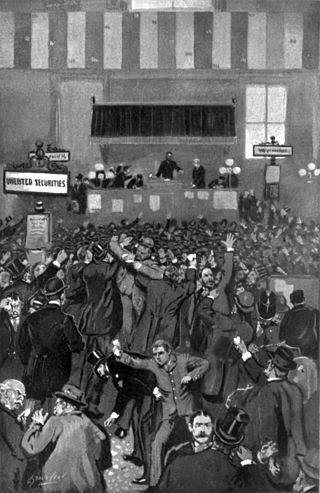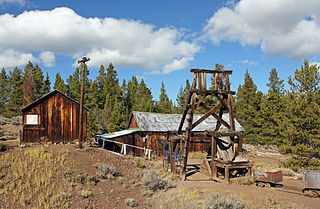Related Research Articles

Winfield Scott Stratton was an American prospector, capitalist, and philanthropist. He discovered the Independence Lode near Victor, Colorado on July 4, 1891, and became the Cripple Creek Mining District's first millionaire in 1894. He provided to build buildings, improve the street car system, build the first professional ball park, and provided funds to people in need.

Leadville is a statutory city that is the county seat, the most populous community, and the only incorporated municipality in Lake County, Colorado, United States. The city population was 2,633 at the 2020 census. It is situated at an elevation of 10,158 feet (3,096 m). Leadville is the highest incorporated city in the United States and is surrounded by two of the tallest peaks in the state.

The Panic of 1893 was an economic depression in the United States that began in 1893 and ended in 1897. It deeply affected every sector of the economy and produced political upheaval that led to the political realignment of 1896 and the presidency of William McKinley.

The region that is today the U.S. State of Colorado has been inhabited by Native Americans and their Paleoamerican ancestors for at least 13,500 years and possibly more than 37,000 years. The eastern edge of the Rocky Mountains was a major migration route that was important to the spread of early peoples throughout the Americas. The Lindenmeier site in Larimer County contains artifacts dating from approximately 8720 BCE.

Davis Hanson Waite was an American politician. He was a member of the Populist Party, and he served as the eighth Governor of Colorado from 1893 to 1895.

The Colorado Silver Boom was a dramatic expansionist period of silver mining activity in the U.S. state of Colorado in the late 19th century. The boom started in 1879 with the discovery of silver at Leadville. Over 82 million dollars worth of silver was mined during the period, making it the second great mineral boom in the state, and coming 20 years after the earlier and shorter Colorado Gold Rush of 1859. The boom was largely the consequence of large-scale purchases of silver by the United States Government authorized by Congress in 1878. The boom endured throughout the 1880s, resulting in an intense increase in both the population and wealth of Colorado, especially in the mountains. It came to an end in 1893 in the wake of the collapse of silver prices caused by the repeal of Sherman Silver Purchase Act.

Free silver was a major economic policy issue in the United States in the late 19th century. Its advocates were in favor of an expansionary monetary policy featuring the unlimited coinage of silver into money on-demand, as opposed to strict adherence to the more carefully fixed money supply implicit in the gold standard. Free silver became increasingly associated with populism, unions, and the perceived struggle of ordinary Americans against the bankers, monopolists, and robber barons of the Gilded Age. Hence, it became known as the "People's Money".

Horace Austin Warner "Haw" Tabor, also known as The Bonanza King of Leadville and The Silver King, was an American prospector, businessman, and Republican politician. His success in Leadville, Colorado's silver mines made him one of the wealthiest men in Colorado. He purchased more mining enterprises throughout Colorado and the Southwestern United States, and he was a philanthropist. After the collapse in the silver market during the Panic of 1893, Tabor was financially devastated. He lost most of his holdings, and he labored in the mines. In his last year, he was the postmaster of Denver.

James Joseph "J.J." Brown, was an American mining engineer, inventor, and self-made member of fashionable society. His wife was RMS Titanic survivor Margaret Brown.

The Argentine Central Railway was a 3 ft narrow gauge railroad in the United States built from the Colorado and Southern Railway at Silver Plume, Colorado, to Waldorf, Colorado, and onward to the summit of Mount McClellan. Construction began on August 1, 1905, and the line was opened to Waldorf a year later on August 1, 1906, a distance of about 16 miles. It was financed and organised by Edward J. Wilcox, owner of 65 mining properties in the Argentine region that were consolidated into the Waldorf Mining and Milling Company in 1902. His headquarters at Waldorf was accessible only by pack mule for much of the year.
Eben Smith was a successful mine owner, smelting company executive, railroad executive and bank owner in Colorado in the late 19th century and early 20th century.
Thomas J. Tarsney was a Populist politician and author in Colorado in the late 19th century.
The History of Denver details the history of the City and County of Denver, Colorado, the United States from its founding in 1858 to modern-day. Ever since the gold rush, Denver has been Colorado’s gateway and major metropolis. With its location at the intersection of the plains and the mountains, its people and institutions have tied together the sections of the state and served as a point of contact between Colorado and the wider world. As the state’s political capital and largest city, Denver has been the natural center for decision-making. New programs and ideas have typically spread outward through the public agencies and private organizations that have Denver headquarters.
Gold mining in Colorado, a state of the United States, has been an industry since 1858. It also played a key role in the establishment of the state of Colorado.

The Leadville mining district, located in the Colorado Mineral Belt, was the most productive silver-mining district in the state of Colorado and hosts one of the largest lead-zinc-silver deposits in the world. Oro City, an early Colorado gold placer mining town located about a mile east of Leadville in California Gulch, was the location to one of the richest placer gold strikes in Colorado, with estimated gold production of 120,000–150,000 ozt, worth $2.5 to $3 million at the then-price of $20.67 per troy ounce.

Elizabeth McCourt Tabor, better known as Baby Doe, was the second wife of Colorado pioneer businessman Horace Tabor. Her rags-to-riches and back to rags again story made her a well-known figure in her own day, and inspired an opera and a Hollywood movie based on her life.

The Holden/Marolt Mining and Ranching Museum is located on the former Holden Lixiviation Works facility on the western edge of the city of Aspen, Colorado, United States. It consists of two remaining buildings from the facility, as well as the relocated McMurchy/Zupancis domestic buildings. In 1990 the property was recognized as a historic district and listed on the National Register of Historic Places, the only district in the city to be so recognized.

The Smuggler Mine is located on the slopes of Smuggler Mountain, on the north edge of Aspen, Colorado, United States. It is the oldest operating silver mine in the Aspen mining district, and one of the few still operating from Aspen's early boom years. In 1987 it was listed on the National Register of Historic Places.

This is a bibliography of the U.S. State of Colorado.

Augusta Pierce Tabor was the wife of a merchant and miner, Horace Tabor, the first white woman to live in the Idaho Springs mining camp, and a Denver philanthropist. She was inducted into the Colorado Women's Hall of Fame in 1991 for her contributions to social service and philanthropy.
References
- Everett, Derek R: “The Colorado State Capitol: History, Politics, Preservation.” University Press of Colorado: Boulder, 2005.
- Ubbelohde, Carl, Maxine Benson, and Duane A. Smith. eds: “A Colorado History." Pruett Publishing Company: Boulder, 1982.
- Leonard, Stephen J. and Thomas J. Noel: “Denver: Mining Camp to Metropolis.” University Press of Colorado: Niwot, 1990.
- Steeples, Douglas and David O. Whitten: “Democracy in Desperation: The Depression of 1893.” Greenwood Press: Westport, 1998.
- Cotton, Jean. "The Silver Crash of 1893: Lore, Legend and Fact.” Web. 17 Feb 2010. <https://web.archive.org/web/20130927133514/http://www.ellensplace.net/hcg_fac8.html>.